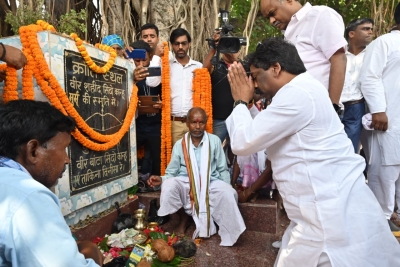By Shambhu Nath ChoudharyRanchi, July 1 : Jharkhand celebrates the ‘Hul Diwas’ every year on June 30 as the Santhal rebellion (also known as the Sonthal rebellion or the ‘Santhal Hul’) shook the mighty British Raj in 1855-56.
Most of the Indian history books mention the ‘Revolt of 1857’ as the first war of Indian independence, however, a large group of researchers and scholars of tribal history have launched a campaign to declare the country’s first war of independence for ‘Santhal Hul’, which started from the Bhognadih village in Jharkhand on June 30, 1855.
On Thursday, Jharkhand Chief Minister Hemant Soren paid tribute at the site of Santhal revolution in Bhognadih and Pachkathia.He said that it is etched in history that tribal community has always been at the forefront in the fight for rights and dignity.
The rebellion started by Santhal tribals and local people against the British rule was led by Sidhu Murmu and Kanhu Murmu, who were hanged to death by the British government.
The two freedom fighters had two other brothers Chand and Bhairav and two sisters Phoolo and Jhano, who also sacrificed their lives during the Hul revolution while fighting against the British rule.
According to tribal history researchers, more than 10,000 Santhal tribals and local people were martyred in this war of independence which lasted for an entire year.
Retired IAS officer Ranendra Kumar, Director of the Ram Dayal Munda Tribal Research Institute run by Jharkhand government, Ranchi, says that Karl Marx has mentioned about this mass independence war in his renowned work ‘Notes on Indian History’.
Before Karl Marx, several English newspapers from London also carried lengthy reports on the Santhal Hul rebellion.
Political philosophers such as Karl Marx only came to know about the indomitable struggle of the tribal people from Jharkhand through several published news articles.
Ranendra Kumar says that under the leadership of Santhal leaders Sidhu, Kanhu, Chand, Bhairav, Phoolo and Jhano, every district in Jharkhand stood up against the mighty Britishers.
Their fighting skills were such that the army of British East India Company was defeated in two separate wars despite being equipped with guns and modern weapons.
The Santhal rebellion heroes fought only with help of primitive weapons and local leaders.
On July 16, 1855, during the Battle of Pirpainti, the army of Major Burroughs or the Burrough Army was defeated by these local tribal leaders.
Similarly on July 21, 1855, the poweful army of Lieutenant Toll Maine had to face defeat in the Battle of Birbhum.
The Government of India had issued a postage stamp on Sidhu-Kanhu in 2002, but till date these local heroes have not got desired credit in history books.
Sudhir Pal, author of the Jharkhand Encyclopedia, says that the tribal rebellion that lasted a year has been ignored in Indian history, while there is a lot of documentation and evidence that due to this 167-year-old battle, the British rule had declined around hills and surroundings in Jharkhand.
The heroes of the Santhal revolution were Sidhu and Kanhu Murmu, who were the children of Chunni Murmu, a resident of Bhognadih village of Sahibganj district in present-day Jharkhand.
Both the local tribal heros had held a large public rally at Bhognadih on June 30, 1855, against the oppressive policies of the British and the Zamindars, in which nearly 20,000 Santhal tribals had gathered.
Ashwini Kumar Pankaj, who has written several books on the tribal history of Jharkhand, has written in an article that “We do not have the complete details of any such revolution mentioned in Indian history even before and after ‘Hul’.”
In all the studies and writings done on Santhal Hul in the last few decades, it has been highlighted that Hul revolution is the first history chapter of the beginning of Indian freedom struggle.
Pankaj says that Santhal Hul rebellion was not just a spontaneous movement against hymn and feudal exploitation.
As per the available documents, it was a well-planned war against the British rule.The preparations were made by Sidhu Murmu of Bhognadih village along with his brothers Kanhu, Chand and Bhairav, prominent Santhal elderly citizens, chieftains and other local artisan and farming communities like Paharia, Ahir, Luhar etc.
When the preparations for Hul rebellion were complete, army teams, guerrilla units, military recruitment-training teams, intelligence teams, economic resource mobilisation teams, logistics teams, publicity teams, help teams, etc.were formed.On June 30, a huge meeting was held and summons were issued to the British to leave the country.
Summons were issued on behalf of the Santhals to the British government under the name ‘Thakur ka Parwana’ in which it was declared that only the Santhals have the right to collect the revenue.
The summons also stated the announcement to restore the rule of the Santhals and the Britishers to vacate the area immediately.However, the British rulers refused to accept these demands.
Thereafter, with the ending of first week of July, the Santhals and the local people started the ‘Hul’ (revolution).There were systematic attacks on markets, the bases of the moneylenders, police stations, British administrative centres.
It took several British troops to suppress this mass movement till 1856, but Hul rebellion leaders fought continuously till 1860-65 against the British Raj.More than 50,000 people from 52 villages were directly involved in this historic struggle for independence.
According to the available documents, the Santhal rebels had captured the Raj Bhavan of Amber Pargana in which a British army officer and several other officers, including 25 officers were killed.
The British army had to fight a fierce battle in suppressing this rebellion which lasted till 1856.
Chand and Bhairav were martyred in the battle at Berhait.
Kanhu was arrested due to a Santhal local who colluded with the British army.
Sidhu was also caught a few days later and was hanged on a banyan tree in Pachkathia while his brother Kanhu was later hanged in Bhognadih village.
snc/sgk/khz/
#Santhal #Jharkhand #Independence #British #Sudhir # Ashwini #Ashwini #Jharkhand #Ranchi #London
.






